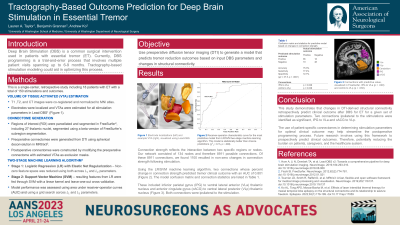Tractography-Based Outcome Prediction for Deep Brain Stimulation in Essential Tremor
Tractography-based Outcome Prediction for Deep Brain Stimulation in Essential Tremor
Friday, April 21, 2023


Lauren A. Taylor (she/her/hers)
Medical Student
University of Washington School of Medicine
Spokane, Washington, United States
ePoster Presenter(s)
Introduction: Deep Brain Stimulation (DBS) is a common surgical intervention used in patients with essential tremor (ET) refractory to pharmacological therapy. DBS success depends on accurate lead placement and the optimization of parameters through postoperative programming. Currently, DBS programming is a generalized process that involves multiple patient visits spanning up to 6-9 months. Due to the lack of patient-specific programming protocols, patients may have suboptimal clinical outcomes leading to patient and caregiver frustration. The goal of this study is to use preoperative diffusion tensor imaging (DTI) to generate a model that predicts tremor reduction outcomes based on input DBS parameters. This study contributes to the creation of a more efficient, patient-specific approach to postoperative DBS programming.
Methods: This is a retrospective study of DBS outcomes for ET in 18 patients. Preoperative MRI and postoperative CT were used to calculate the volume of tissue activated from a given stimulation. A two-stage machine learning algorithm, including logistic regression with elastic net regularization followed by support vector machine classification, was applied to predict tremor reduction from the change in preoperative DTI-derived connectivity features following DBS.
Results: Changes in connection strength predicted the presence of ET reduction with an accuracy of 75.3%, sensitivity of 77.4%, specificity of 72.7%, and AUC of .801. This model was statistically better than chance predictions (χ2 = 37.5, p = .000). Two connections with predictive value were identified—ipsilateral inferior parietal gyrus to ventral lateral anterior thalamic nucleus (p = .03) and ipsilateral anterior cingulate cortex to ventral lateral posterior thalamic nucleus (p = .04).
Conclusion : DBS tremor reduction outcomes can be predicted using changes in patient-specific, DTI-derived connectivity for a given set of stimulation parameters. These results will help streamline the postoperative process of DBS programming, possibly resulting in decreased toll on patients, caregivers, and the healthcare system.
Methods: This is a retrospective study of DBS outcomes for ET in 18 patients. Preoperative MRI and postoperative CT were used to calculate the volume of tissue activated from a given stimulation. A two-stage machine learning algorithm, including logistic regression with elastic net regularization followed by support vector machine classification, was applied to predict tremor reduction from the change in preoperative DTI-derived connectivity features following DBS.
Results: Changes in connection strength predicted the presence of ET reduction with an accuracy of 75.3%, sensitivity of 77.4%, specificity of 72.7%, and AUC of .801. This model was statistically better than chance predictions (χ2 = 37.5, p = .000). Two connections with predictive value were identified—ipsilateral inferior parietal gyrus to ventral lateral anterior thalamic nucleus (p = .03) and ipsilateral anterior cingulate cortex to ventral lateral posterior thalamic nucleus (p = .04).
Conclusion : DBS tremor reduction outcomes can be predicted using changes in patient-specific, DTI-derived connectivity for a given set of stimulation parameters. These results will help streamline the postoperative process of DBS programming, possibly resulting in decreased toll on patients, caregivers, and the healthcare system.
